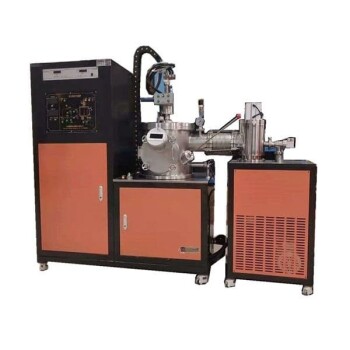At its core, arc melting is a process that uses the intense heat from an electric arc to melt metals. This is achieved by passing a high-current electric charge between electrodes and the metallic charge, creating a plasma arc with temperatures capable of reaching several thousand degrees Celsius, which rapidly liquefies the material.
The fundamental principle of arc melting is to convert electrical energy into extreme thermal energy, much like a controlled, sustained lightning strike. This makes it a powerful and efficient method primarily for melting steel scrap on an industrial scale.

How Arc Melting Works: The Core Mechanism
The process, most commonly seen in an Electric Arc Furnace (EAF), is a powerful display of thermal conversion. It follows a distinct sequence to transform solid metal into a molten bath.
Creating the Electric Arc
An EAF uses large-diameter graphite electrodes. These electrodes are lowered into the furnace until they are just above the charge of solid metal (often scrap steel). A massive electrical current is then applied.
The current jumps the gap between the electrode tip and the metal, ionizing the air and creating a stable, high-temperature plasma arc.
Generating Intense Heat
This arc is the sole source of heat. It is not a flame or combustion process. The plasma arc can reach temperatures exceeding 3,000°C (5,400°F), transferring immense thermal energy directly to the metal charge.
The Melting Process
The heat radiates from the arc and directly strikes the metal, causing it to melt rapidly. As the scrap melts, the electrodes are automatically lowered further into the furnace to maintain the arc and melt the remaining material, forming a molten pool at the bottom.
Arc Melting vs. Induction Melting: A Critical Distinction
It is common to confuse arc melting with induction melting, but they operate on entirely different physical principles and are suited for different tasks. The information you may have encountered about induction melting does not apply to the arc melting process.
The Heat Source
The defining difference is the method of heat generation.
- Arc Melting: Uses a high-energy electric arc (a plasma discharge) that flows from an electrode to the metal.
- Induction Melting: Uses an electromagnetic field generated by a coil to induce electrical currents within the metal itself, causing it to heat up and melt from the inside out (resistance heating).
Typical Applications
Their distinct mechanisms lead to different primary uses.
- Arc Melting: Dominates large-scale steel recycling. EAFs can process hundreds of tons of scrap steel in a single batch, making them the backbone of "mini-mill" steel production.
- Induction Melting: Excels in producing high-purity or specialty alloys in smaller, more controlled batches. It is common in foundries and for applications where precise chemistry is critical.
Understanding the Trade-offs
Like any industrial process, arc melting has clear advantages and specific operational challenges that define its use case.
Advantage: Raw Material Versatility
An EAF's primary strength is its ability to melt large, un-densified scrap metal. The sheer power of the arc can handle a wide variety of shapes and sizes, reducing the need for extensive pre-processing of the charge material.
Advantage: High Speed and Temperature
The direct application of intense heat allows for very fast melt times compared to other methods. This high throughput is essential for the economics of modern steel production.
Disadvantage: High Electrode Consumption
The graphite electrodes are sacrificial; they are consumed during the process through sublimation and breakage. This represents a significant and continuous operational cost.
Disadvantage: Extreme Electrical Demand
EAFs are among the largest single electrical loads on any power grid. They require a dedicated, robust power infrastructure and incur massive electricity costs, a factor known as "flicker" that can destabilize local power grids if not managed properly.
Making the Right Choice for Your Goal
Selecting the correct melting technology depends entirely on your scale, material, and final product requirements.
- If your primary focus is large-scale steel production from scrap: Arc melting in an EAF is the undisputed industry standard for its speed and ability to handle raw scrap.
- If your primary focus is high-purity metals or specialty alloys in controlled batches: Induction melting offers superior chemical control and is better suited for smaller, cleaner operations.
- If your primary focus is minimizing contamination from electrodes: Induction melting is the clear choice as it is a contactless process with no electrodes to wear away.
Ultimately, choosing the right tool is about matching the process capabilities to your specific metallurgical objective.
Summary Table:
| Aspect | Arc Melting (EAF) | Induction Melting |
|---|---|---|
| Heat Source | Electric arc (plasma) | Electromagnetic field |
| Primary Use | Large-scale steel scrap recycling | High-purity & specialty alloys |
| Scale | Industrial (hundreds of tons) | Smaller, controlled batches |
| Key Advantage | Handles raw, un-densified scrap | Superior chemical control, no electrode contamination |
Need the right melting solution for your lab or production facility?
KINTEK specializes in lab equipment and consumables, serving precise laboratory needs. Whether you're exploring melting processes for research or scaling up production, our expertise can help you select the optimal equipment for your specific materials and goals.
Contact our experts today to discuss your application and discover how we can support your success.
Visual Guide

Related Products
- Vacuum Arc Induction Melting Furnace
- Lab-Scale Vacuum Induction Melting Furnace
- Vacuum Induction Melting Spinning System Arc Melting Furnace
- Vacuum Heat Treat Furnace and Levitation Induction Melting Furnace
- Small Vacuum Heat Treat and Tungsten Wire Sintering Furnace
People Also Ask
- What does VAR mean steel? A Guide to Vacuum Arc Remelting for High-Purity Steel
- What is the vacuum arc remelting process? Producing Ultra-Pure, High-Performance Metal Alloys
- What is a remelting process? A Guide to High-Purity Metal Refinement
- How does vacuum arc remelting work? Achieve Ultra-Clean, High-Performance Metal Alloys
- What is the benefit of vacuum arc remelting? Achieve Superior Metal Purity and Structural Integrity



















